Example of Rational Algebraic Expression (With Solution)

We know that a fraction is a rational number that consists of integers as its numerator and denominator. But what if instead of integers, we replace them with polynomials?
Let me introduce you to the concept of rational expressions – the ratio of two polynomials. In this reviewer, we are going to review its definition and mathematical operations.
Click below to go to the main reviewers:
Ultimate PMA Entrance Exam Reviewer
Ultimate PNP Entrance Exam Reviewer
Table of Contents
What Is a Rational Expression?
A rational expression (or rational algebraic expression) is a ratio of two polynomials. Think of it as a fraction but instead of whole numbers, its numerator and denominator are polynomials.
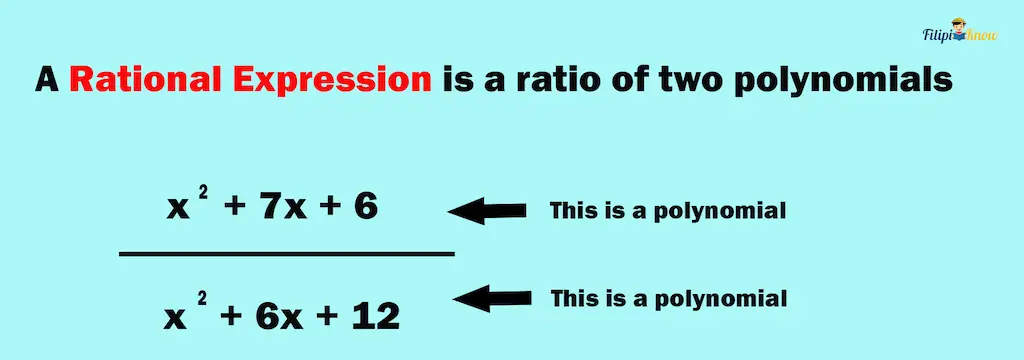
Formally, a rational expression R(x) is the ratio of two polynomials P(x) and Q(x), such that the value of the polynomial Q(x) is not equal to 0 (because division by 0 is undefined).
R(x) = P(x)∕Q(x), where Q(x) ≠ 0
Example: Which of the following is/are rational expressions?
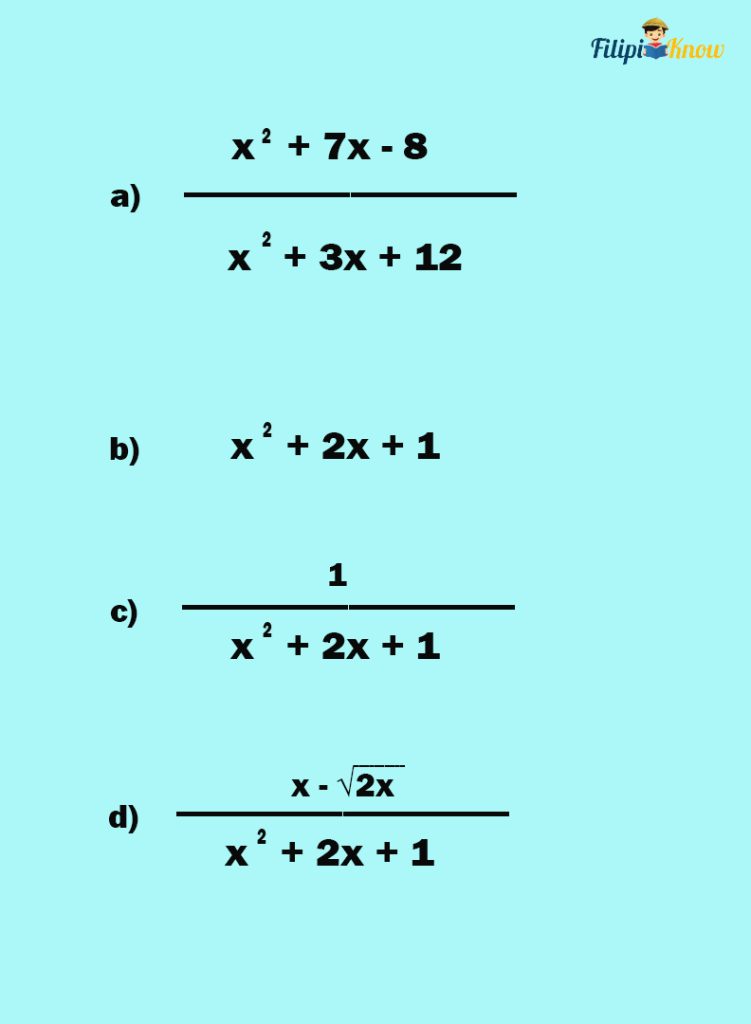
Solution:
The expression in a) is a rational expression since both its numerator and denominator are polynomials.
The expression in b) is also a rational expression because x2 + 2x + 1 can be expressed as:
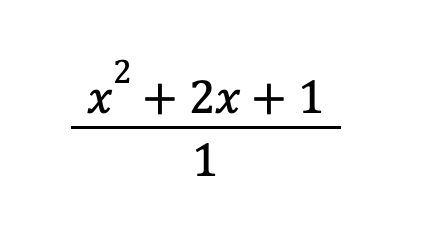
Take note that a constant can be considered a polynomial. Thus, b) has a numerator and denominator that are both polynomials.
The expression in c) is also a rational expression since its numerator (which is 1) is a polynomial while its denominator is also a polynomial.
The expression in d) is not a rational expression since its numerator is not a polynomial. Recall that if a variable is under the radical sign, then the expression is not a polynomial.
Simplifying Rational Expressions
Just like fractions, we can also reduce rational expressions into their simplest form. A rational expression is said to be in its simplest form if and only if its numerator and denominator have no common factor except 1.
For instance, let us take a look at the following rational expression:
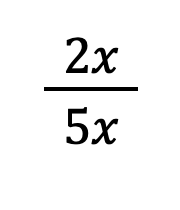
If we factor both the numerator and denominator, you will notice that there’s a common factor between them. That common factor is x:
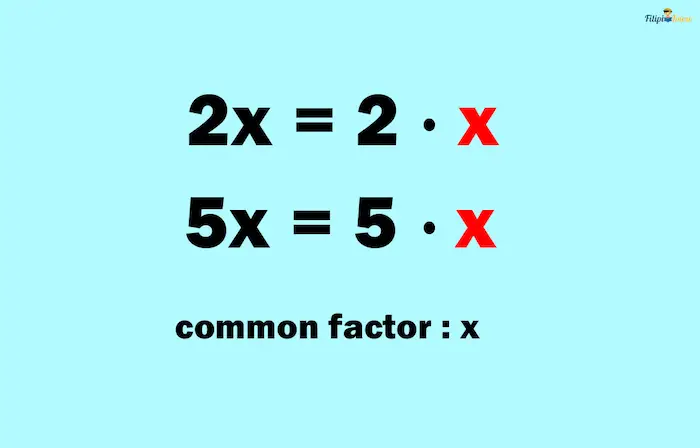
We can cancel out the common factor:
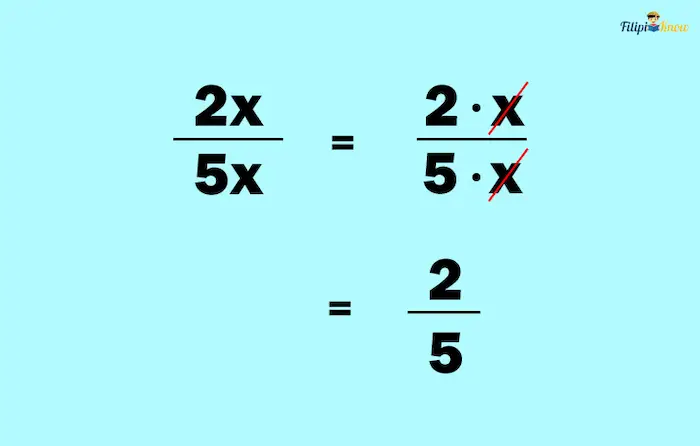
What’s left with us is ⅖. Both 2 and 5 are prime and have no common factor except 1. Therefore, the simplified form of the rational expression in this example is ⅖.
How To Simplify Rational Expressions: 3 Steps
Here are the steps to simplify a rational expression:
- Factor the numerator and the denominator.
- Look for the common factors between the numerator and the denominator.
- Cancel out the common factors between the numerator and the denominator.
Example 1: Simplify the following rational expression:
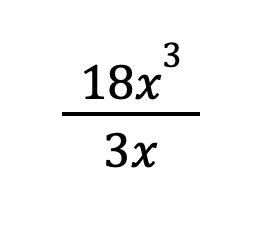
Solution:
1. Factor the numerator and the denominator.

2. Look for the common factors between the numerator and the denominator.

3. Cancel out the common factors between the numerator and the denominator.
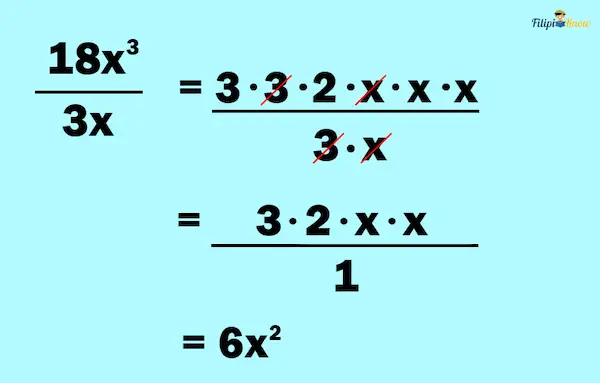
Thus, the simplified form of the rational expression is 6x2.
Example 2: Simplify the following rational expression:
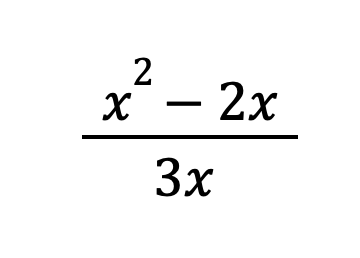
Solution:
1. Factor the numerator and the denominator
We can factor out x2 – 2x as x(x – 2) by factoring using the Greatest Common Factor (GCF).
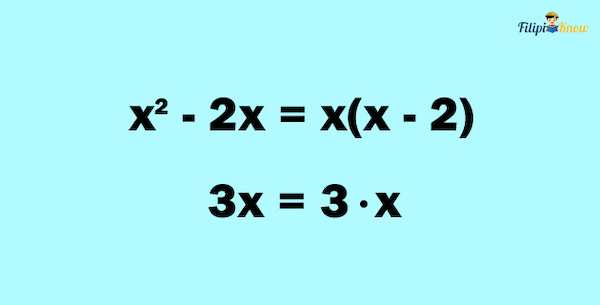
2. Look for the common factors between the numerator and the denominator
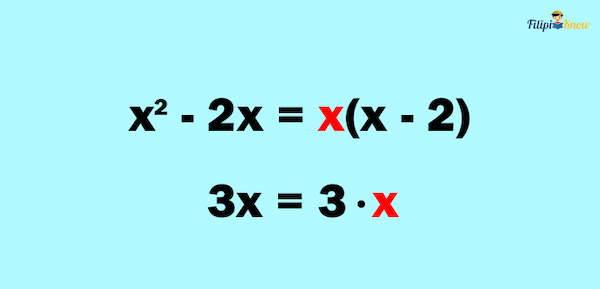
3. Cancel out the common factors between the numerator and the denominator
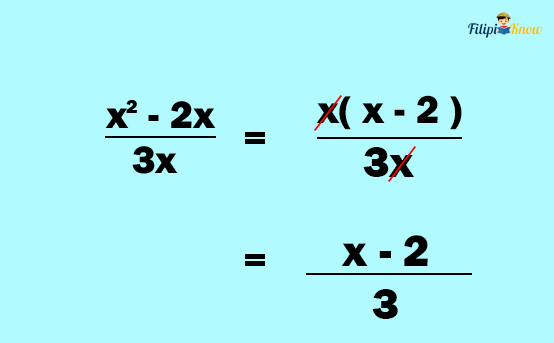
Example 3: Simplify the following rational expression:
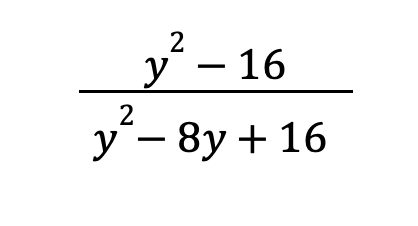
Solution:
1. Factor the numerator and the denominator
Since y2 – 16 is a difference of the two squares, we can factor it as (y + 4)(y – 4). On the other hand, y2 – 8y + 16 is a perfect square trinomial that we can factor as (y – 4)(y – 4).
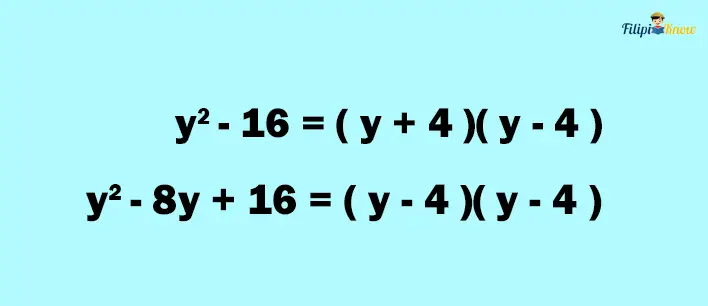
2. Look for the common factors between the numerator and the denominator

3. Cancel out the common factors between the numerator and the denominator
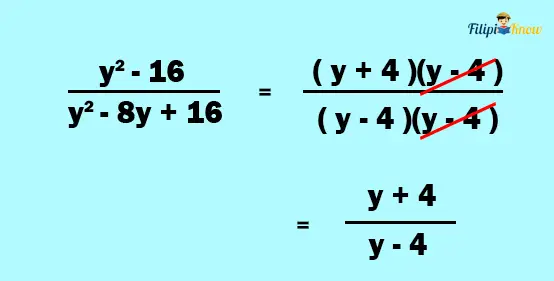
Example 4: Simplify the following rational expression:
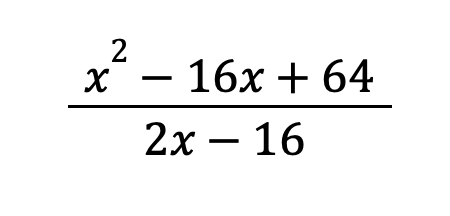
Solution:
1. Factor the numerator and the denominator
Since x2 – 16x + 64 is a perfect square trinomial, we can factor it as (x – 8)(x – 8). Meanwhile, we can factor 2x – 16 as 2(x – 8) using its GCF.
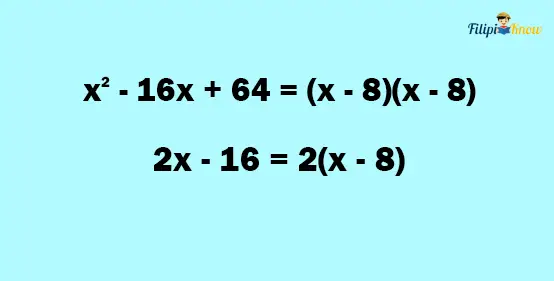
2. Look for the common factors between the numerator and the denominator
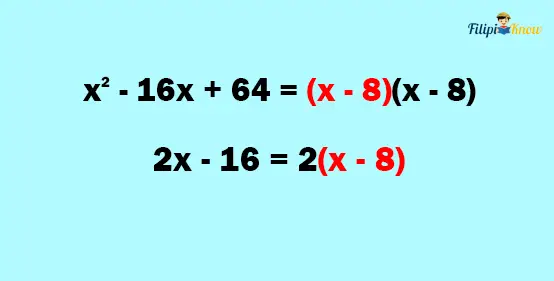
3. Cancel out the common factors between the numerator and the denominator
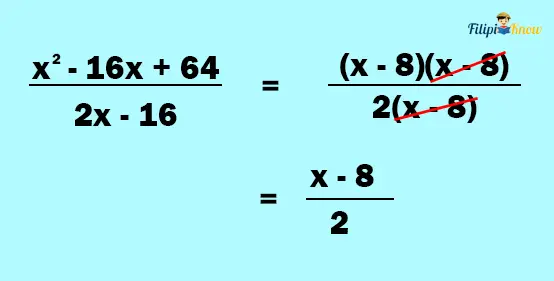
Example 5: Simplify the following rational expression:
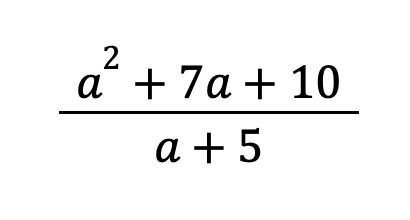
Solution:
1. Factor the numerator and the denominator
We can factor a2 + 7a + 10 as (a + 5)(a + 2).
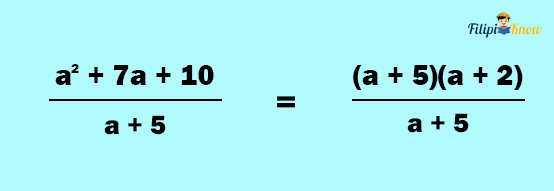
2. Look for the common factors between the numerator and the denominator
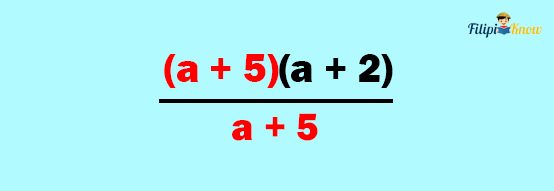
3. Cancel out the common factors between the numerator and the denominator
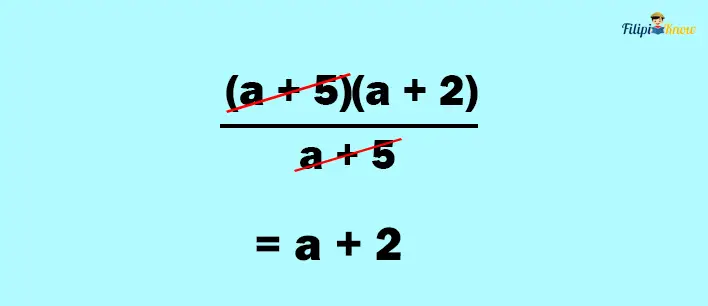
Therefore, the simplified form of the rational expression is a + 2.
Example 6: Simplify the following rational expression:
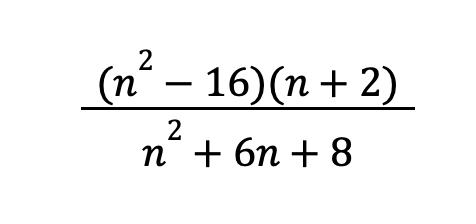
Solution:
1. Factor the numerator and the denominator
We can factor n2 – 16 as (n + 4)(n – 4). Meanwhile, we can factor n2 + 6n + 8 as (n + 4)(n + 2).
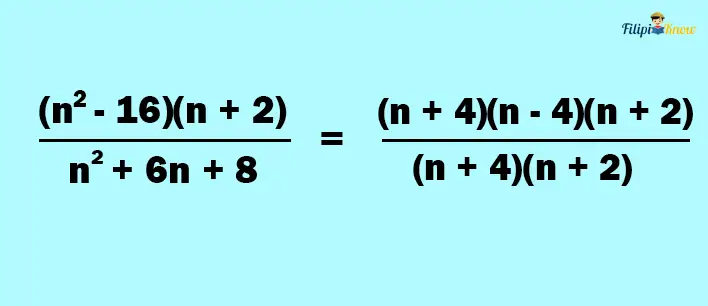
2. Look for the common factors between the numerator and the denominator
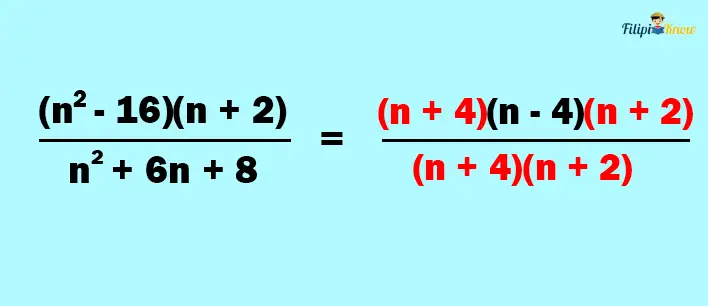
3. Cancel out the common factors between the numerator and the denominator

Thus, the answer to this example is n – 4.
How To Find the Least Common Denominator (LCD) of Rational Expressions
Before we study how to apply basic operations to rational expressions, you must learn first how to find the Least Common Denominator (LCD) of rational expressions.
To find the LCD of rational expressions, follow these steps:
- Factor the denominators of the rational expressions.
- Write the factors of the denominators. Match the common factors in columns.
- Bring down each factor in every column. Common factors in the column must be brought down also.
- Multiply the factors you brought down. The resulting expression is the LCD.
Example 1:

Solution:
The denominators of the given expressions are x – 1 and x2 – 1. Our task is to determine their Least Common Denominator using the steps above:
1. Factor the denominators of the rational expressions.
x – 1 cannot be factored further. Meanwhile, since x2 – 1 is a difference of two squares, we can factor it as (x + 1)(x – 1).
2. Write the factors of the denominators. Match the common factors in columns
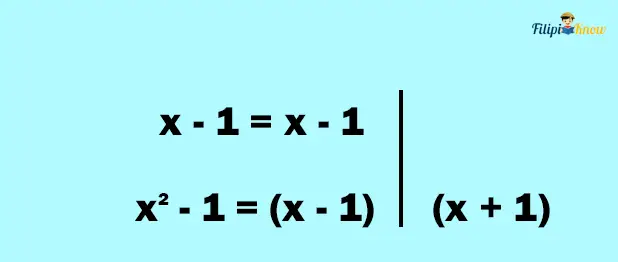
3. Bring down each factor in every column. Common factors in the column must be brought down also
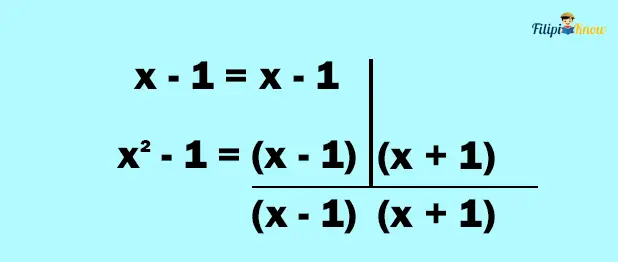
4. Multiply the factors you brought down. The resulting expression is the LCD
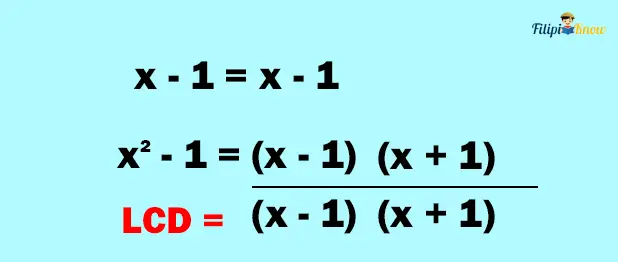
Thus, the LCD is (x + 1)(x – 1) or x2 – 1.
Example 2:

Solution:
1. Factor the denominators of the rational expressions.
x2 + 7x + 10 can be factored as (x + 5)(x + 2). Meanwhile, x2 + 4x + 4 can be factored as (x + 2)(x + 2).
2. Write the factors of the denominators. Match the common factors in columns
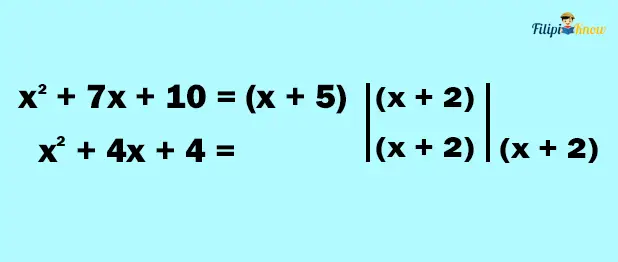
3. Bring down each factor in every column. Common factors in the column must be brought down also
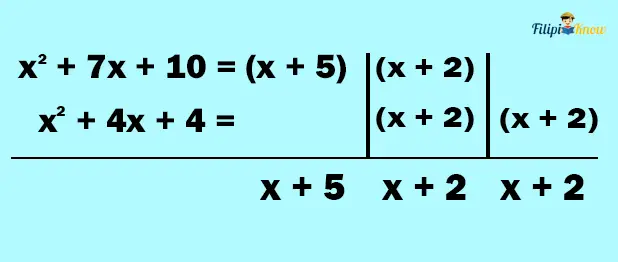
4. Multiply the factors you brought down. The resulting expression is the LCD
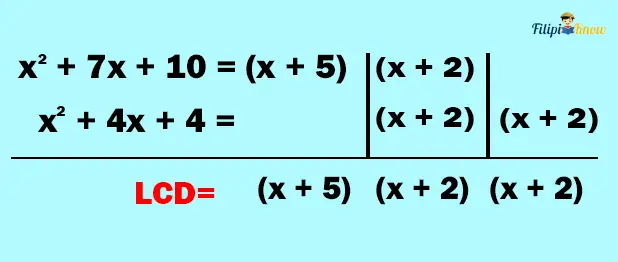
Based on our computations above, the LCD of x2 + 7x + 10 and x2 + 4x + 4 is (x + 2)(x + 2)(x + 5).
Note: When we are determining the LCD of two rational expressions, it is advisable to write the obtained LCD in factored form since expressions are much easier to multiply and divide if they are in factored form.
Make sure that you already mastered the skill of determining the LCD of rational expressions before proceeding to the actual process of adding and subtracting them.
Operations on Rational Expressions
In this section, we’ll discuss how to add, subtract, multiply, and divide rational expressions.
1. Addition and Subtraction of Rational Expressions
The process of adding and subtracting rational expressions is actually similar to the process of adding and subtracting fractions. Thus, if you know how to add or subtract fractions, then adding and subtracting rational expressions will not be so strange to you.
The first thing you have to do when adding or subtracting rational expressions is to look at their denominators. If the denominators are the same, then we can just add the numerators of the rational expressions and then copy the denominator.
a. Addition and Subtraction of Rational Expressions With the Same Denominator
Here are the steps in adding rational expressions with the same denominator:
- Add the numerators of the rational expressions. The resulting expression is the numerator of the answer.
- Copy the common denominator and use it as the denominator of your answer.
- Simplify the resulting rational expression, if possible.
Formally,

Example 1:

Solution:
1. Add the numerators of the rational expressions. The resulting expression is the numerator of the answer
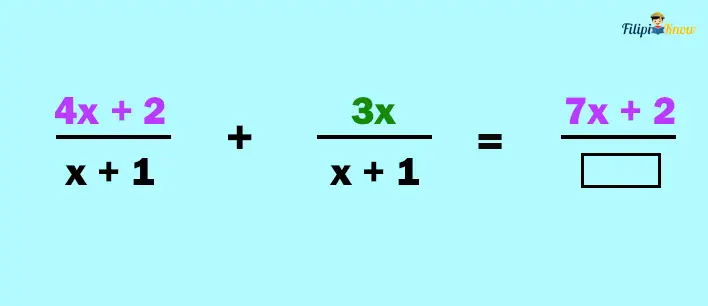
2. Copy the common denominator and use it as the denominator of your answer
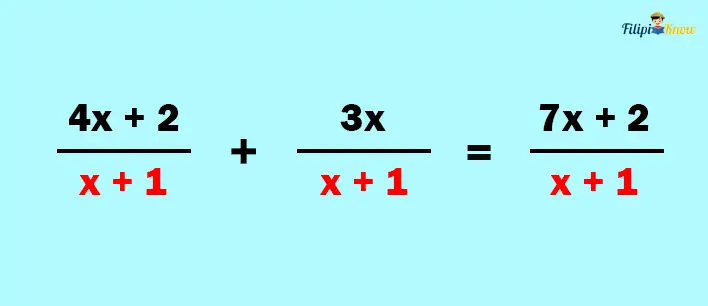
3. Simplify the resulting rational expression, if possible
In this case, we can’t simplify the resulting rational expression further so it automatically becomes the final answer.
Example 2:

Solution:
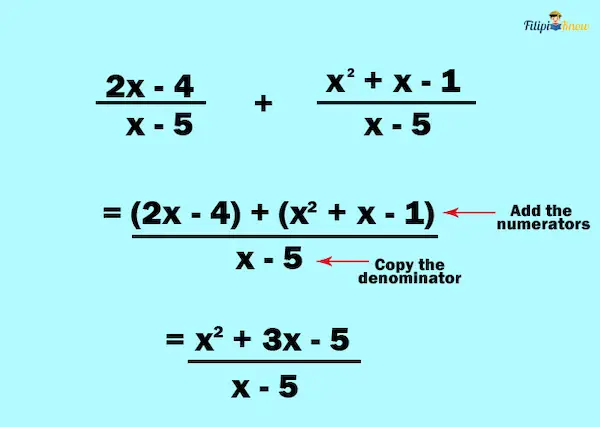
Example 3:

Solution:
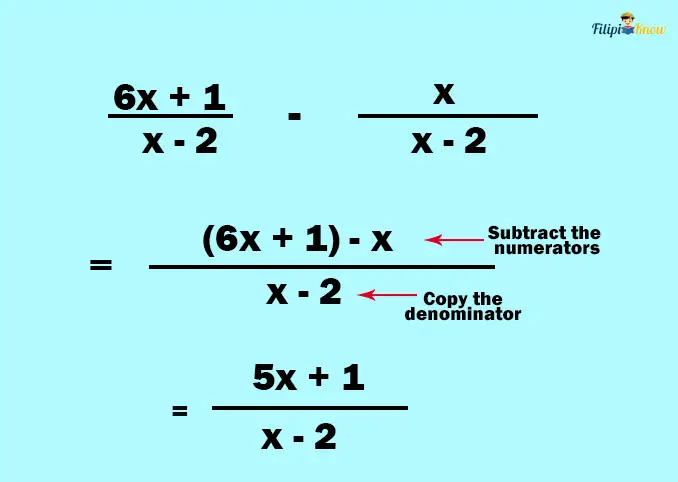
Example 4:

Solution:
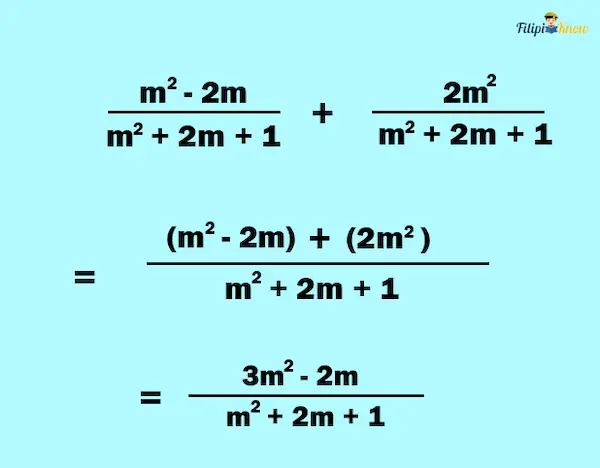
Example 5:

Solution:
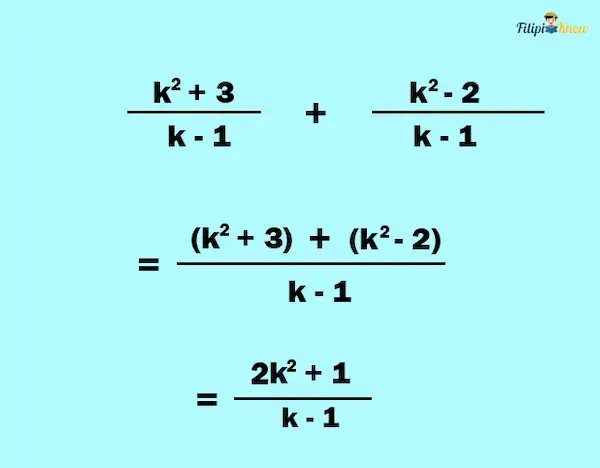
Now that you know how to add and subtract rational expressions with the same denominators, our next goal is to learn how to add and subtract rational expressions with different denominators.
b. Addition and Subtraction of Rational Expressions With Different Denominators.
To add or subtract rational expressions with different denominators, follow these steps:
- Determine the LCD of the rational expressions.
- Express the given rational expressions using the LCD you have obtained by dividing the LCD by the denominator of the rational expression and then multiplying the result to the numerator of the rational expression. The results will be the new numerators of the rational expressions.
- Add or subtract the rational expressions you have obtained from the second step. Simplify the resulting expression, if possible.
Let us try to apply these steps to our examples below:
Example 1:
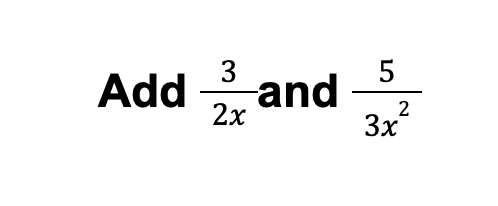
Solution:
Using the steps we have mentioned above on adding and subtracting rational expressions with different denominators, we’ll be able to obtain the answer.
1. Determine the LCD of the rational expressions.

2. Express the given rational expressions using the LCD you have obtained by dividing the LCD by the denominator of the rational expression and then multiplying the result to the numerator of the rational expression. The results will be the new numerators of rational expressions.
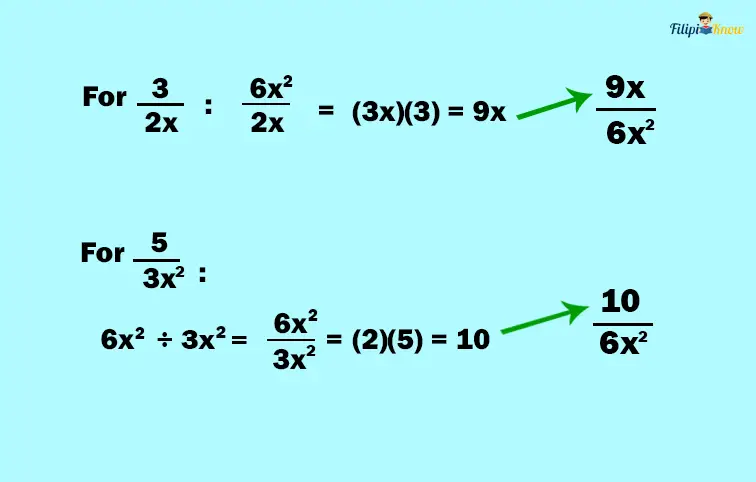
3. Add or subtract the rational expressions you have obtained from the second step. Simplify the resulting expression, if possible.
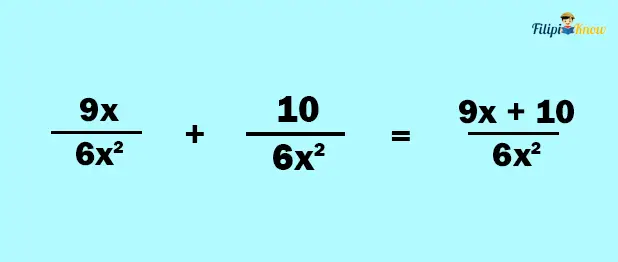
Example 2:

Solution:
1. Determine the LCD of the rational expressions.
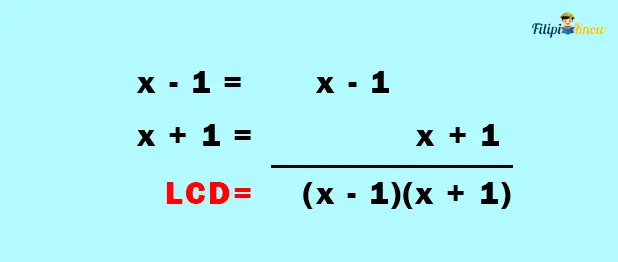
The LCD is (x – 1)(x + 1).
2. Express the given rational expressions using the LCD you have obtained by dividing the LCD by the denominator of the rational expression and then multiplying the result to the numerator of the rational expression. The results will be the new numerators of rational expressions.
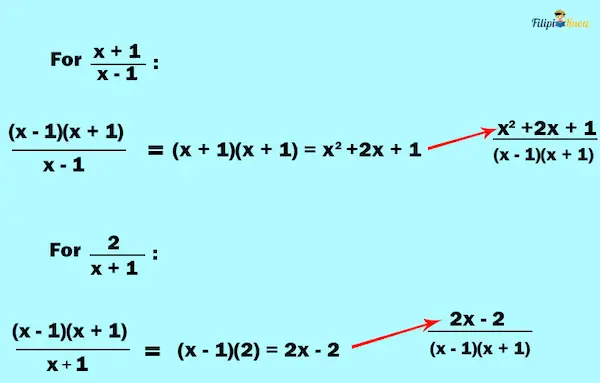
3. Add or subtract the rational expressions you have obtained from the second step. Simplify the resulting expression, if possible.
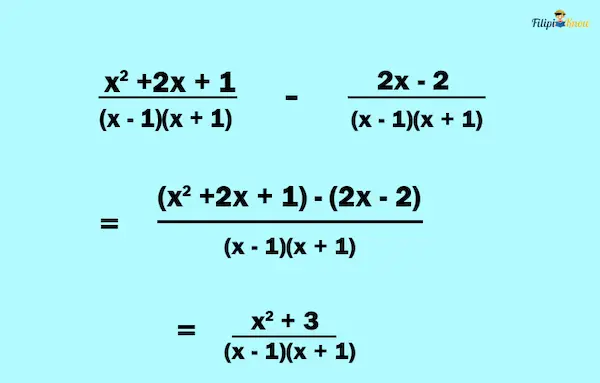
Example 3:

Solution:
1. Determine the LCD of the rational expressions
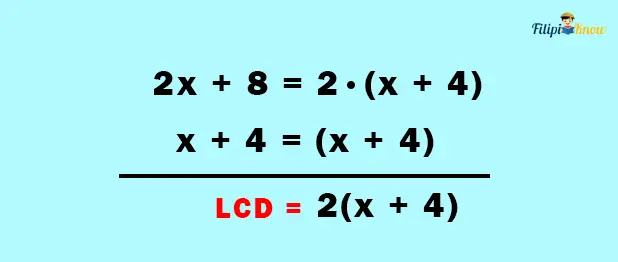
2. Express the given rational expressions using the LCD you have obtained by dividing the LCD by the denominator of the rational expression and then multiplying the result to the numerator of the rational expression. The results will be the new numerators of the rational expressions.
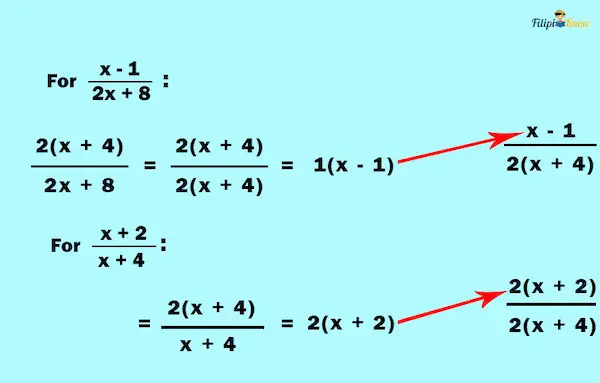
3. Add or subtract the rational expressions you have obtained from the second step. Simplify the resulting expression, if possible.
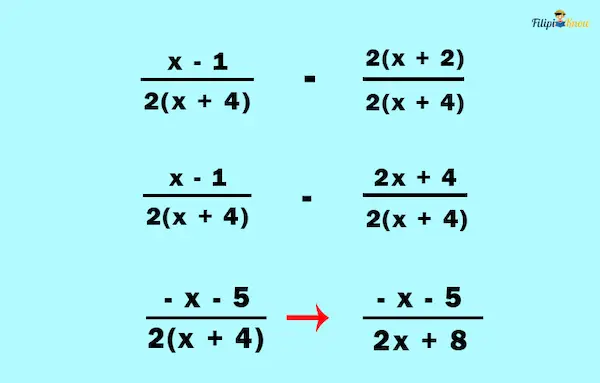
2. Multiplication of Rational Expressions
The steps in multiplying rational expressions are actually similar to the steps in multiplying fractions. Here are the steps:
- Multiply the numerators of the rational expressions. Write the answer as the numerator of the resulting expression.
- Multiply the denominators of the rational expressions. Write the answer as the denominator of the resulting expression.
- Simplify the resulting expression, if possible.
Example:
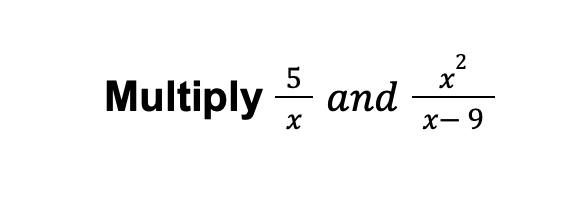
Solution:
Using the steps in multiplying rational expressions:
1. Multiply the numerators of the rational expressions. Write the answer as the numerator of the resulting expression.
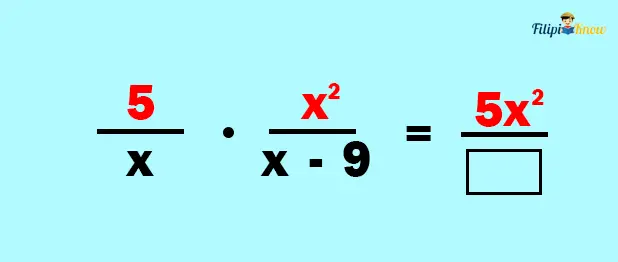
2. Multiply the denominators of the rational expressions. Write the answer as the denominator of the resulting expression.
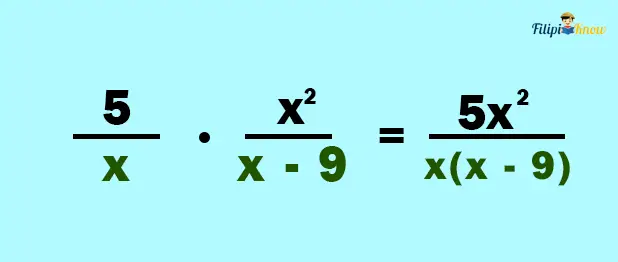
We will not perform distributive property in this case since we are simplifying the expression in the next step.
3. Simplify the resulting expression, if possible.
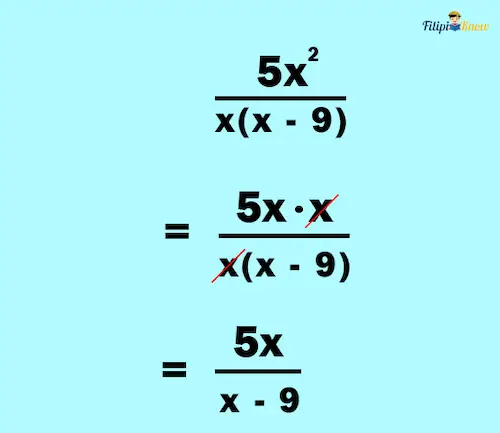
Using Cancellation Method in Multiplying Rational Expressions
Just like fractions, we can also apply the cancellation method to cancel out common factors among the given expressions to make our computation much easier. Let us try to apply this technique in our next examples.
Example 1: Apply the cancellation method to calculate the product of
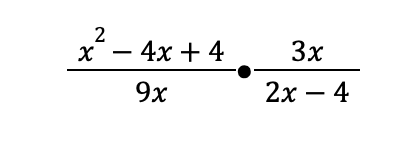
Solution:

Example 2:

Solution:

3. Division of Rational Expressions
If you still remember how to divide fractions, dividing rational expressions will be easier because the steps are actually similar. Otherwise, here are the steps you need to remember when dividing rational expressions:
- Get the reciprocal of the divisor or the second rational expression.
- Multiply the rational expression you have obtained in Step 1 by the first rational expression.
- Simplify the result, if possible.
Example 1:
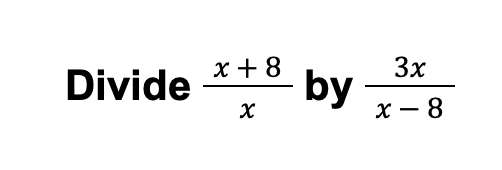
Solution:
1. Get the reciprocal of the divisor or the second rational expression.

2. Multiply the rational expression you have obtained in Step 1 by the first rational expression.
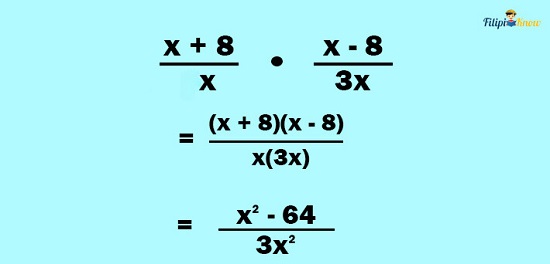
3. Simplify the result, if possible.
The result is already in simplified form, so we can skip this step.
Example 2:

Solution:
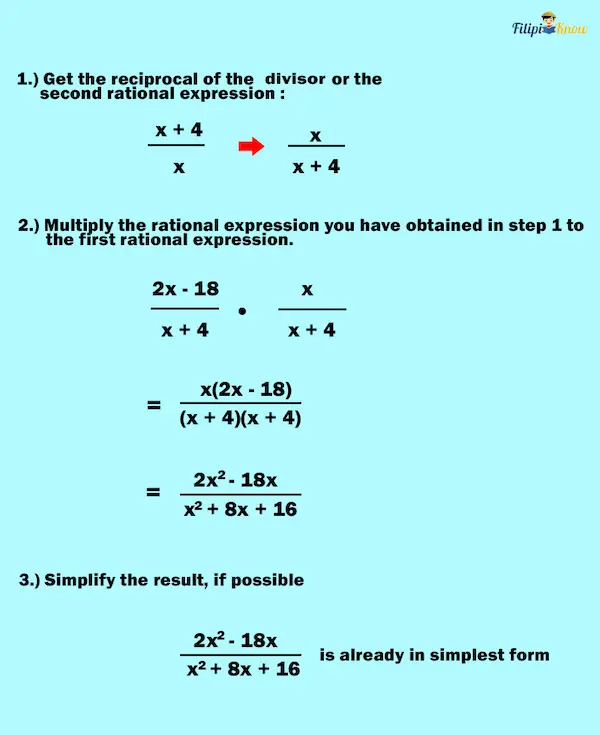
Next topic: Radical Expressions
Previous topic: Quadratic Equations
Return to the main article: The Ultimate Basic Math Reviewer
Download Printable Summary/Review Notes
Download Printable Flashcards
Test Yourself!
1. Practice Questions [Free PDF Download]
2. Answer Key [Free PDF Download]
3. Math Mock Exam + Answer Key
Written by Jewel Kyle Fabula
in College Entrance Exam, LET, NAPOLCOM Exam, NMAT, PMA Entrance Exam, Reviewers, UPCAT
Jewel Kyle Fabula
Jewel Kyle Fabula graduated Cum Laude with a degree of Bachelor of Science in Economics from the University of the Philippines Diliman. He is also a nominee for the 2023 Gerardo Sicat Award for Best Undergraduate Thesis in Economics. He is currently a freelance content writer with writing experience related to technology, artificial intelligence, ergonomic products, and education. Kyle loves cats, mathematics, playing video games, and listening to music.
Copyright Notice
All materials contained on this site are protected by the Republic of the Philippines copyright law and may not be reproduced, distributed, transmitted, displayed, published, or broadcast without the prior written permission of filipiknow.net or in the case of third party materials, the owner of that content. You may not alter or remove any trademark, copyright, or other notice from copies of the content. Be warned that we have already reported and helped terminate several websites and YouTube channels for blatantly stealing our content. If you wish to use filipiknow.net content for commercial purposes, such as for content syndication, etc., please contact us at legal(at)filipiknow(dot)net